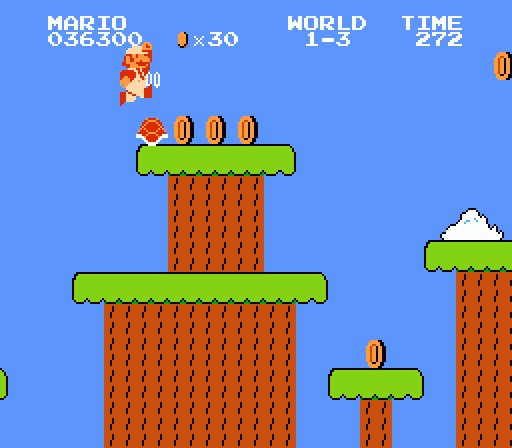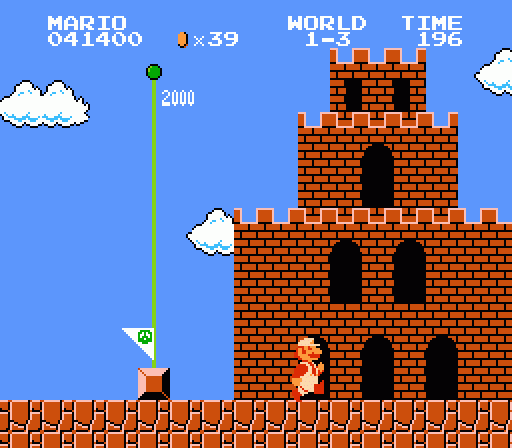Super Mario Bros.‘s first couple of stages ease players into the rules of the game’s world: Walking, jumping, stomping, fireballs, secrets. With World 1-3, however, the game properly becomes a platformer. At this point, you’re expected to have a handle on the basics so you can contend with the more complex demands ahead.

World 1-3 takes place across a vast chasm dotted by a series of… trees? Mushrooms? Cliffs? I don’t honestly know. It doesn’t really matter. The important thing is that the only solid ground in World 1-3 appears at the very beginning and very end of the stage. In between, it’s all just a series of slippery platforms. Fall off an edge and Mario plummets to his death.
Looking back after 25-odd years of games inspired by Super Mario, I think it’s worth noting that the green platforms here are solid from both above and below. You can’t pass through them by leaping; instead, you have to jump cleanly around them. The brown “walls” are strictly window dressing; they serve no purpose in the game except to convey the idea that you’re not traveling across platforms floating in empty space. They actually do provide a sort of comforting presence, though, inane as that may sound — it’s strictly psychological, but I contend that the brown walls/trunks/stems/whatever create a reassuring sensation that you’re not in quite as perilous as a situation as you might be. They’re wallpaper training wheels.

But World 1-3 really is hazardous. Platforms appear at variable heights and at different distances from one another, forcing players to make bold leaps in order to progress. Coins exist not only as a power-up — and if you’ve been gathering them dutifully, you’ll finally discover here that 100 coins nets you an extra life — but also as a ruse to entice you to perform dangerous actions. Is it really worth the risk of dropping down in the narrow space between two platforms to a tiny ledge with a single coin on it? Probably not, but that jingling sound they make when you collect them just can’t be denied. It’s pavlovian, baby.
The moving platforms that served as one-way elevators reappear here, but in a different capacity. Instead of simply descending or ascending all the way off the screen, looping infinitely, they move back and forth either horizontally or vertically within a fixed space. They can take you up to higher areas or across to otherwise unreachable spaces. And unlike the green platforms, these aren’t solid ground; you can leap from beneath them to land on their upper edge. They’re more forgiving due to their more dangerous nature.

The most important thing to understand in World 1-3 is the importance of running. You can clear the first two worlds without ever pressing the B button, but forget about advancing past World 1-3 if you don’t run. In several places, you must target platforms too high and too far across a gap to jump by simply walking forward; you need the added momentum and height provided by a short run-up.
And if you’re feeling really fancy, you can experiment with the advanced technique of stomping aerial enemies. Hopping on a bad guy causes Mario to bounce, of course, so it stands to reason that would work even in mid-air. And indeed, hopping on a Koopa Paratroopa can propel Mario to a higher ledge, though of course you need to watch your timing. (There are some weird physics quirks in Super Mario that allow bizarre exploitation, like the fact that colliding with an enemy while in a downward motion registers a stomp even if the enemy hits you from above, but those are outside the scope of a piece on deliberate design lessons).

Make no mistake, World 1-3 still has its training wheels on. The most complex maneuver you need to pull off in order to clear the stage is jumping from one moving platform to the other. But these move gently up and down next to one another, alternating with the other and meeting at the midpoint of their arc. It’s child’s play to jump from the left one at the apex of its track to the right one, which will be at its nadir at the same time. But it’s an essential trick to master for later in the game, when things become far more stressful.

The color-coded enemies demand attention, too. The only Koopas and Paratroopas in this stage are red ones, which stick to a fixed range. Red Koopas never walk off edges, patrolling only their designated platform, while Red Paratroopas hover up and down along a vertical line. You can pop them with fireballs to make short work of them, or you can experiment with kicking them from uneven terrain.
At any rate, the level itself proves to be exceptionally brief. Not only is it shorter than Worlds 1-1 and 1-2, it also lacks their nuances. There are no hidden secrets here, no pipes or invisible blocks. In fact, there’s only one block in total, which disgorges a mushroom or Fire Flower as needed. The focus here is entirely on aerial maneuvers and high-altitude platforming, with no distractions beyond the shiny, shiny coins.

At the end of the stage — which is preceded by a very different sort of staircase than those of 1-1 and 1-2 — Mario enters a proper castle, not just the tiny fortresses of the previous worlds. This will prove to be a meaningful distinction.
The game never tells you this, but I’ve heard that the coins in a #-3 stage are the factor that determines if the hidden 1UP block in the next #-1 stage will spawn. If you collect them all, the block will spawn.
I’ve tested it out myself, and it looks to be true.
Your point about the run button still holds today. Being as its hard for me to get 4 real people who know how to play Mario together for the remakes. The only time I’ve actually played 4 player on the “New” games is when the neighbor kids come over to play with my kid “And my games” they usually never get past the first world or two because they never use the run button and figured out how it makes you jump better. It’s always a disaster. You really need that run feature to make any progress past the first few levels of all main Mario games. It seems watching kids over the years like my nieces and nephews that that is the biggest impediment to kids playing Mario good is not mastering using run with the jump. I try to teach them but for small kids more an one button seems to confuse them. On the other hand I’ve seem savant 6 years olds playing this game at the 7-11 back in the 80’s beat the game in a matter of minutes without dying. Go figure.
Ah, but if you’re referring to NSMB Wii, then that’s a different story… using the Wiimote sideways is pretty much the worst “controller” I’ve ever used, and that game forces it on you. Even I couldn’t get very far in NSMBW for this very reason.
Now that you mention it it’s funny that I never thought about the brown walls as windowdressing. I always took for granted that they were needed as supporting structures for the green platforms. Ridiculous, I know.
Nope, that shows how effective an idea it was.
So thanks to this series I went and dusted off the ol’ SMB (via 3DS VC) and played through the first couple world sets for the first time in ages. And man… Mario’s control is a lot more slippery than I remembered. More than once I skidded off the edge of a platform to my doom when I wasn’t expecting to. It’s easy to forget that while SMB was definitely a platforming revelation in its time, the “basically perfect Mario platforming” engine we all know and love was the product of successive tweaks and refinements over the course of several games.
This isn’t to say SMB1’s physics is *bad*, of course. Just different enough to throw you if you’re in a SMW and/or NSMB mindset.
True. But consider its contemporaries!
And the 3DS is kind of butt for NES games.